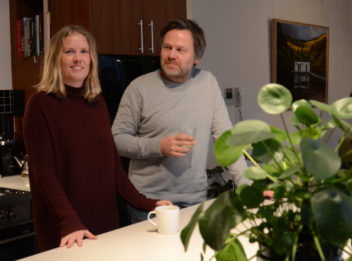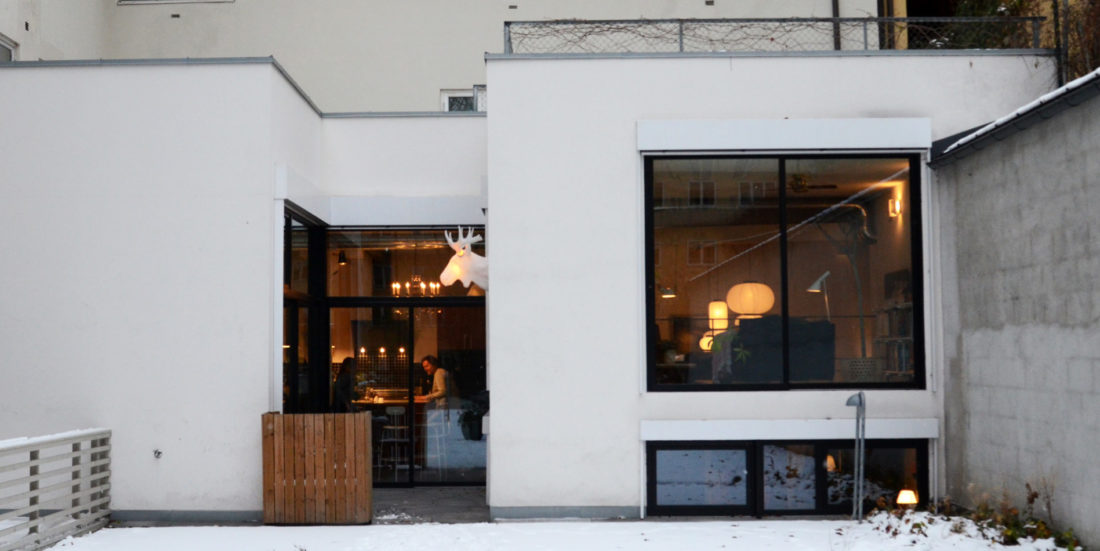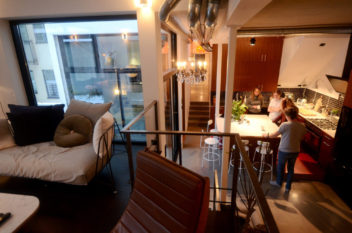Making a car workshop into an attractive, energy-efficient urban residence
Combining old and new to achieve reduced energy consumption, a better living environment and architectural success. It’s definitely possible and researchers will show you how.
“I think we’ve been given the best of both worlds. Layers of history and pure soul. We started with an old building, superimposed with a layer of modernity because the building was upgraded”, says John Andreas Andersen.
He is drinking coffee beside the kitchen island in the apartment in Bislett in Oslo, into which he and his partner Henriette Løberg Carlsen have recently moved.
The apartment was formerly a disused car workshop and garage, and is one of 12 upgrade projects being presented in SINTEF’s collection of examples entitled ‘Revitalising housing upgrades’.

Satisfied residents enjoying a coffee in the old workshop that is now a super modern kitchen. Photo: Lisbet Jære.
Inspiring regenerative design
According to the report, regenerative design is an approach to sustainable design which is based on preserving existing qualities, and revitalising, developing and renewing a building without compromising its original value and quality.
“Our aim with the collection is to inspire architects, home-owners and the building industry by presenting upgraded homes that use less energy, provide a better living environment and are architecturally successful”, says researcher Solvår Irene Wågø of SINTEF Building and Infrastructure. She is an architect herself, and has been commissioned by Husbanken to work on the project.
Regenerative design is about upgrading homes in a coordinated and sustainable way by linking the issues of energy consumption and greenhouse gas emissions with social and urban challenges. The concept originates in the USA, and is not well known in Norway, but this collection of examples is an attempt to provide practical illustrations of the concept. The researchers developed 10 objectives intended to serve as guidelines for housing upgrades (see the fact box).
From disused garage to cool residence
The architects behind the upgrade of the apartment in Bislett are Caroline Hatlen Støvring and Cecilie Wille of Morfeus Arkitekter. From what was once an abandoned and disused car workshop and garage in an apartment block in Bislett in Oslo, built in 1937, they have developed a light-filled, urban apartment. Anyone going down the stairs at the main entrance might well expect to enter a gloomy basement apartment, but they will get a pleasant surprise when they enter this light-filled space. It is built on several levels, with parts of the living room built above the two bedrooms used by Andersen’s children.
“It’s exciting to work with transformation projects, since you’re not only working to preserve original features, but also to find new and modern solutions. I think we’re going to see more and more of this. Making use of derelict structures in cities is important, not least in Oslo where there is tremendous pressure on the housing market”, says Støvring.
The kitchen, dining room and living room have been combined into one general purpose space with huge glass windows facing out onto the rear courtyard.
Making good use of available space is environmentally friendly
The apartment has water-borne heating and central heating between September and May. Heat storage materials have also been used in the floor, roof and walls. This saves energy and ensures an even distribution of temperature.
“For us, living in such a central location is extremely important. We have an electric car and a charging socket just outside, but usually we walk or cycle. We try to live in as environmentally friendly way as possible”, says Løberg Carlsen, who says that energy consumption in the apartment is low.
Støvring explains that they worked hard to find effective ways of minimising energy consumption. Another environmental challenge given careful consideration was the processing and sorting of hazardous waste on the site, because it had previously been a car workshop.
Facts – 10 objectives of regenerative design
- Upgrade the building’s climate shell
- Improve the heating and cooling systems
- Improve living conditions
- Activate natural systems and improve the efficiency of technical systems
- Reduce energy consumption
- Preserve cultural and historic values
- Support the development of biological and social diversity
- Reduce waste and promote re-use
- Influence behaviour
- Energise social and physical surroundings
“Transformation projects and making good use of available space is a little more challenging than building from scratch, because you’re working in close proximity to existing buildings and neighbours. The process was difficult at times, but fortunately over time our dialogue with the municipality and neighbours became very positive”.
Green terrace
The roof of the apartment has been converted into a terrace for everyone in the housing cooperative, and turfed with grass and the green plant sedum. The roof terrace ticked several of the regenerative design objective boxes, including energising social and physical surroundings, increasing biological diversity and improving residential qualities.
Sedum is a plant that can survive in thin soils and dry conditions. It absorbs water, and protects against flooding after heavy rain and snow. It also has insulating properties and captures dust and other particles from the urban air. It is more expensive than standard types of roofing, but it is maintenance-free.
“Bees, honeybees and birds are attracted to the green roof. It’s also aesthetically pleasing and attractive, and is overlooked by all the windows in the block”, says Støvring, pointing up at the roof from the rear courtyard which is now covered in snow.
The most attractive block on the street
The report does not just contain examples of apartments and single-family homes, but also apartment blocks. One of them is the Granli housing cooperative in Oslo, where a cold, old-fashioned façade was transformed by features including the installation of timber balconies. Retrofitting insulation has improved the building’s insulation capacity by 80 per cent.
“Residents say that their block has gone from being the ugliest on the street to the most attractive, and has become their pride and joy. It has raised the standard of the entire neighbourhood.
“When people renovate a building, they tend to focus on the kitchen and bathroom, and perhaps do a bit of painting. But there are enormous benefits to be gained by looking at things in a bigger context”, says Wågø.
She believes that the housing cooperative is an excellent example of how a large-format, coordinated upgrade works well in terms of sustainability, energy efficiency, flexibility and operating costs, and also accommodates future needs and statutory requirements.
“Working on building conservation and energy upgrades at the same time presents particular challenges, and means that we have to develop new solutions. A regenerative approach means taking into account the multiple perspectives that must be considered when upgrading a home or neighbourhood”, says Solvår Wågø.






